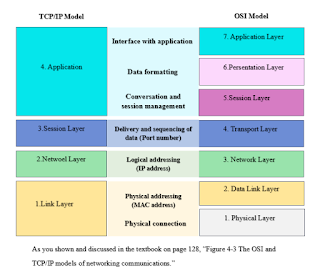Week Five: Cloud Networking
This week objectives covered an array of topics
like, Networking Concepts in the Cloud, which is in conjunction to, Networking
Concepts, From OSI Model to Cloud Stack, and Software-Defined Networking in the
Cloud to IP Address Space, also in conjunction also to IP Addressing,
Subnetting, Cloud Network Interfaces, and many more.
Let’s dive into discussing some little but
important aspects and details that are associated with some of the topics listed
above. You can always pursuit other articles throughout the Internet to be
better orientated for your preferences.
Networking Concepts in the Cloud
1. The
OSI Model to Cloud Stock:
The OSI (Open
System Interconnection) Model and the TCP/IP (Transmission Control
Protocol/Internet Protocol) Model have some similar features and operations,
just like every other technology we utilized. The TCP/IP and the OSI models
work hands-in-hand to allow the flow of communication on any given network, and
the diagram above shows how communication transpires. The OSI Model has a total
of seven layers (protocols), and the TCP/IP Model has a total of four layers, -
three less than OSI, but more powerful with greater efficiency.
Regardless of
whether in the OSI model or the TCP/IP model, the process of adding additional
information to a document (data) as it travels down from layers-to-layers in
computer networking is considered as encapsulation. Think of encapsulation as
working on an assembly line in a bakery where all employees on that assembly
line are assigned to add an ingredient on dope as the dope role down the
conveyor line. Encapsulation is the process of accomplishing various tasks (each
layer adds a header) to maintain information (communication) as it travels
downward from layers to layers until it reaches its destination.
IP Address Spaces
1. IP
Address:
In an on-perm (company
owned) network, DHCP (Dynamic Host Configuration Protocol) server can be
configurated for the purpose of normally assigning private IP addresses, while
it is automatic in cloud IP address assignment. It is informative to know that “Private
IP addresses are assigned chronologically from specific IP address ranges that
are defined when you create the virtual network and its subnets.” The concept for
implementing the proper applications (practices) for IP “address allocation on
private network” is RFC (Request for Comments) 1918 and was published February
of 1996 by IETF (Internet Engineering Task Force). More details on RFC 1918 can
be found at: https://datatracker.ietf.org/doc/html/rfc1918
which identifies three IP address space blocks that are reserved by IANA
(Internet Assigned Numbers Authority) for private networks use, “including
private networks hosted in the cloud.” These blocks of reserved IP address
space are:
|
Class of networks |
Start address |
End Address |
Prefix |
Subnet mask |
|
Class A network |
10.0.0.0 |
10.255.255.255 |
10x.x.x/8 |
255.0.0.0 |
|
Class
B network |
172.16.0.0 |
172.31.255.255 |
172.16.x.x/12 |
255.240.0.0 |
|
Class C network |
192.168.0.0 |
192.168.255.255 |
192.x.x/16 |
255.255.0.0 |
Reference
West, Jill. (2023).
CompTIA Cloud+ Guide to Cloud Computing (p. 133). Kindle Edition. Retrieved: October
5, 2023.

Comments
Post a Comment